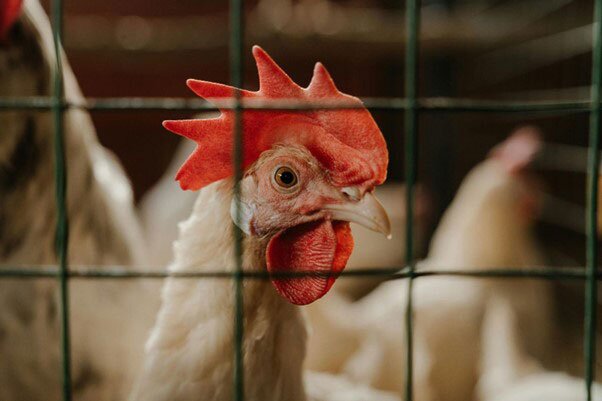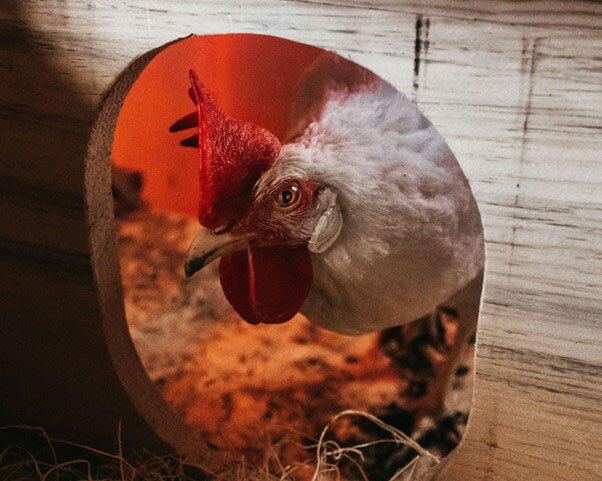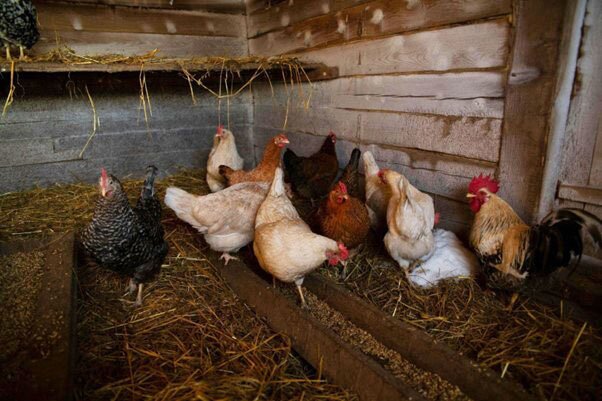Raising chickens can be a rewarding experience, offering fresh eggs and a sense of self-sufficiency. However, it’s also a big responsibility and includes protecting your flock from predators, particularly foxes, which can be a challenge. Building a fox-proof chicken coop requires careful planning and the use of robust materials, but it's worth it to maintain the safety and health of your hens.

This guide will give tips for building and maintaining a fox-proof chicken coop, ensuring your chickens stay happy and healthy. We'll also cover the essential elements of a coop, including the best types of wire mesh to use and tips for deterring other pests. We’ll cover:
What is a chicken coop?
A chicken coop is a structure designed to provide chickens with a safe and comfortable space for sleeping, laying eggs, and sheltering from predators and harsh weather. Coops typically consist of an enclosed indoor area where chickens can sleep, rest, and lay eggs, along with an external run that offers a secure, uncovered space for chickens to explore outdoors. The size of your coop will depend on the number of chickens you plan to keep.

In the UK, it is a legal requirement to register as a poultry keeper, regardless of the number of birds. There are two registration processes: one for those keeping 49 or fewer birds and another for those with 50 or more. You can find more information and access the relevant forms on the official government website.
Additionally, local authorities may have specific regulations around poultry keeping, particularly in urban areas, so be sure to check the rules in your area. Your local council may also be able to advise you on the size and location of your chicken enclosure to ensure it complies with planning regulations.
At this stage, you may also want to research which breed of chickens is most appropriate for your needs. If having a ready supply of tasty eggs is important to you, you could consider breeds like the Rhode Island Red, Sussex, or Leghorn chicken. Different breeds have unique temperaments and requirements, so it’s important to do thorough research to ensure you can provide the right habitat and care for your chosen breed.
How to build a fox-proof chicken coop
You can purchase ready-made coops or coop kits that just need assembling in your garden. However, if you prefer to build a custom coop yourself, there are a few important factors to consider to ensure it provides a safe and comfortable environment for your chickens.

Here’s everything you'll need to build a fox-proof chicken coop:
- 50mm x 50mm chicken enclosure mesh. We recommend this mesh for chicken coops as it offers excellent protection from foxes and can withstand tough weather conditions. The 14 gauge wire (approx. 2mm thick) makes it stronger and more rigid than chicken wire netting or other lightweight welded meshes.
- Fence posts.
- Fencing tools, including wire cutters, staple guns, and pliers.
- Roofing material.
- Doors and windows.
- Hinges and latches (ideally sliding bolts).
- Chicken feeders.
- Chicken waterers.
Location
Before you begin, think carefully about the location of your coop. It should be in a well-drained area to avoid waterlogging and close enough to your house for easy access, but far enough away to prevent any unpleasant smell from wafting into your home.
Foundations
Begin by laying a solid foundation. A raised platform works well, as this can help prevent foxes from burrowing up and under the floor. If raising the coop isn't possible, you can also line the floor with a fox-proof metal mesh to prevent burrowing. Cover the mesh with wood chippings designed specifically for chicken runs. These chippings help keep the ground dry, as well as provide a comfortable and stimulating environment for your chickens that encourages their natural scratching, pecking and foraging behaviours.
Frame
Next, build a solid wooden frame with strong joints and attach a fox-proof wire mesh. Foxes are by far the biggest threat to your chickens, so it's crucial to select a mesh that will provide effective protection from them. Although traditional hexagonal chicken wire might seem suitable, it isn’t effective against foxes, as they can easily chew through the thinner material.
Instead, we recommend using a medium-weight 50mm galvanised welded wire mesh with a 14 gauge (2mm thick) wire, or a 25mm x 25mm hole weld mesh with a 16 gauge (1.6mm thick) wire. This mesh should be strong and rigid enough to provide excellent protection from foxes. For longevity, opt for a mesh with a European galvanized finish, as this is highly weather- and rust-resistant.
If you are looking to keep out wild birds and rats as well as foxes, then you may want to go for a 13mm x 13mm hole weld mesh with a 16 gauge (1.6mm thick) wire.
Outer perimeter
Foxes are persistent and resourceful predators. They can chew through weak wire, climb over fences, and dig under the coop to gain access. So, it’s important to secure all sides of your coop, including the top and bottom, using a sturdy wire mesh.
To prevent foxes from burrowing, extend the wire mesh at least 30cm (12 inches) into the ground around the perimeter of the coop. If digging isn’t possible, lay the mesh flat on the ground around the coop, creating a ‘skirt’ that you can secure with heavy-duty ground pegs. For extra security, you might consider installing a chain link fence around the run, especially for larger flocks.
Weatherproofing and security
While fox-proofing is a top-priority, your coop should also offer a cosy and weatherproof home for your chickens. Use a waterproof material such as tar paper to cover the roof, ensuring it slopes to allow rainwater to run off. This will prevent the wood from becoming soft or warped.
To prevent your chickens from getting out and predators from getting in, fit solid doors with sturdy latches — preferably sliding bolts, which are more secure than rotating latches. Cover windows with chicken wire or fox-proof mesh to protect against predators in the event of breakages.
How to keep foxes away from chicken runs
In addition to building a study, fox-proof chicken coop, there are other steps you can take to help deter foxes from breaking in.

In addition to building a study, fox-proof chicken coop, there are other steps you can take to help deter foxes from breaking in.
First, keep the coop and run clean and tidy, and always store chicken feed in secure containers with tight-fitting lids. This will help prevent attracting not only foxes but also other pests like rats, mice, and insects, all of which pose risks to your chickens. Maintaining good hygiene inside the coop will also promote the health and happiness of your flock.
You may also want to consider additional deterrents, such as motion-activated lights. Foxes are nocturnal and prefer darkness, so installing lights around the coop can startle and scare them off. Foxes also dislike certain scents; for instance, the smell of lavender, citrus, peppermint, or spices can deter them, so you could try creating a homemade fox repellent using essential oils. Motion-activated noisemakers and water sprinklers can also be used to startle foxes when they approach your coop.
Lastly, regular maintenance is key to ensuring your coop remains secure. An adult fox can fit through a hole just 4 inches (10cm) square (Hastings Borough Council). So, be sure to inspect the coop and run for any weak spots, gaps, or holes that could provide entry points for foxes. Repair any issues as soon as they arise to prevent your coop from becoming an easy target.
What should be inside a chicken coop?
Chickens are curious, social animals that need mental and physical stimulation to stay happy and healthy, so it's important to add some enrichment to their coop. Provide toys, perches, and a varied environment for them to explore. Chickens need to engage in dust-bathing to keep their plumage healthy, so ensure they have adequate space for this.

Inside your coop, roosting bars are essential as chickens need a place to perch at night. Install sturdy roosting bars at least 2 feet above the ground, ensuring there is enough space for each bird. For egg-laying, provide one nesting box for every 4–5 hens, lining them with straw or wood shavings to create a cosy environment.
Good ventilation is crucial for preventing respiratory issues, so install vents near the roof to promote air circulation while keeping the coop dry. To keep pests out, you can apply mouse, bee, and wasp vent covers. You can find more insect mesh tips in our guide to fly and insect-proofing your home.
For bedding, use straw, hay, or wood shavings to keep the coop dry and comfortable. Regularly change the bedding to maintain cleanliness and minimise odours. Finally, ensure your hens always have access to fresh water and high-quality feed by using feeders and waterers designed to prevent tipping and spilling.
Here at Mesh Direct, we can provide you with all the materials you need to put together an animal enclosure, whether it’s aviary mesh, mesh for small animals, or dog fencing. To keep pests out, we have a variety of solutions from fine insect mesh to rat-proof steel wire mesh. To discuss your needs, why not get in touch?
Regular maintenance and vigilance are key to keeping predators at bay and ensuring your chickens thrive, so be sure to browse our fencing parts and fittings too. With the tips and techniques outlined in this guide, you'll be well on your way to successfully raising chickens and protecting them from foxes and other pests.




